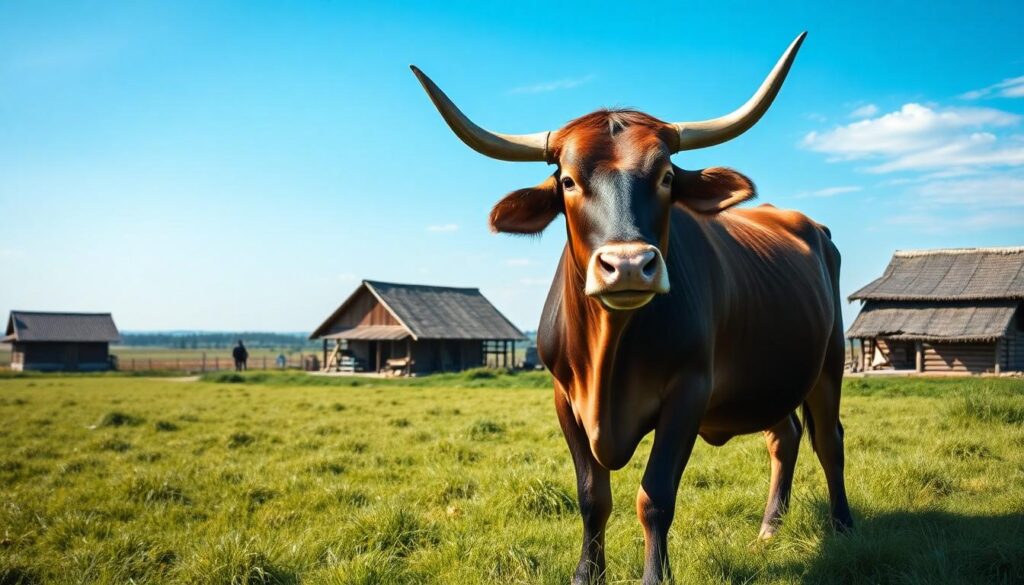Looking for the perfect name for your ox? We’ve gathered an exceptional collection of ox names that combine strength, character, and charm. Whether you’re naming a working farm animal or seeking inspiration for a mascot, our comprehensive list has something for everyone.
Oxen have played a crucial role throughout history, serving as powerful draft animals and loyal farm companions. Their steadfast nature and impressive strength deserve to be honored with a name that truly captures their essence. From traditional names rooted in farming heritage to creative options that highlight their powerful presence, we’ll help you find the ideal name for these magnificent animals.
The Historical Significance of Ox Names in Agriculture
Throughout agricultural history, oxen have played a pivotal role in farming communities worldwide, with their names carrying deep cultural significance. Naming practices for these powerful draft animals evolved from practical identification needs to meaningful traditions that reflected a community’s values and beliefs. Farmers often chose names that highlighted an ox’s strength or character traits, establishing a personal connection that acknowledged the animal’s contribution to their livelihood.
In ancient civilizations, ox names frequently honored deities associated with agriculture and prosperity. Egyptian farmers named their oxen after gods like Apis, while Roman agricultural workers chose names connecting to Saturn, their harvest deity. These naming practices served both practical and spiritual purposes, as farmers believed proper naming could bring divine protection to their crucial working animals.
Colonial American farmers developed distinct naming traditions for their ox teams, typically giving paired animals complementary names like “Buck and Bright” or “Gee and Haw.” These paired names reflected the animals’ working relationship and made issuing commands more intuitive during fieldwork. Documentation from 18th-century New England farms shows consistent naming patterns that became regional traditions passed through generations.
Asian agricultural societies, particularly in China and India, selected ox names based on auspicious meanings and favorable symbolic associations. Names translating to concepts like “Prosperity,” “Golden,” or “Blessed” were common, reflecting the belief that an appropriately named ox would bring good fortune to the farm. These naming customs remained relatively unchanged for centuries, demonstrating their cultural importance.
European farming communities often followed naming conventions based on physical characteristics or temperament. Names like “Stout,” “Steady,” or “Mighty” acknowledged the animal’s working qualities and role on the farm. Historical farm records from 16th-century England reveal remarkably consistent naming patterns across different regions, indicating deeply established cultural practices.
Modern historical research recognizes these naming traditions as valuable insights into agricultural communities’ values and beliefs. Anthropologists studying these practices have documented how ox names reflected the close relationship between farmers and their working animals. The careful selection of meaningful names demonstrated respect for these essential partners in agricultural production.
10 Traditional Ox Names From Around the World

While oxen aren’t typically given personal names like pets, various cultures have developed unique naming traditions for these powerful draft animals. These names often reflect the ox’s role, physical characteristics, or cultural significance.
European Ox Naming Traditions
European farmers traditionally identified their oxen by practical descriptors rather than personal names. Oxen were commonly referred to by their breed types such as Brown Swiss or Angus, making identification straightforward in agricultural settings. Farm owners frequently used simple color-based names or numbers to distinguish between multiple working animals. Draft oxen might be called by terms describing their function, such as “plow ox” or “cart ox,” emphasizing their primary role on the farm. These naming conventions prioritized utility over sentiment, reflecting the practical relationship between European farmers and their working animals.
Asian Ox Naming Customs
Asian cultures developed more personalized naming traditions for oxen that often carried symbolic significance. In rural India, farmers bestowed names like “Bhima” (meaning strong) or “Lakshmi” (after the goddess of prosperity) to invoke strength and good fortune for their working animals. Chinese agricultural communities named oxen based on distinctive physical features, with names such as “Jiaozi” (meaning horned one) for an ox with unique horn shapes. Japanese farmers sometimes used the prefix “Gyū” (meaning ox) followed by descriptive terms that highlighted the animal’s power or utility. Names like “Tsunagi,” meaning strong and powerful, were given to oxen in Japan to reflect their impressive strength and endurance. These naming practices demonstrate how Asian cultures viewed oxen not merely as tools but as valued partners worthy of names that honored their contributions.
How to Choose the Perfect Name for Your Working Ox

Considering Your Ox’s Personality
Personality traits often serve as excellent inspiration when naming your working ox. In many cultures, oxen receive names that directly reflect their unique behaviors or working characteristics. Pairs of oxen traditionally got complementary names that suited their individual personalities or working styles. This practice was especially common in southern England, where farmers would specifically name the near-side ox and the off-side ox with paired names that highlighted their relationship. Consider observing your ox’s temperament—is it patient, stubborn, gentle, or particularly hardworking? These distinctive behavioral traits can point you toward the perfect name that captures your ox’s essence.
Naming Based on Physical Characteristics
Physical attributes have historically dominated the way farmers name their oxen across different cultures. Color patterns, size, and distinctive features all provide natural inspiration for practical and memorable names. Many traditional farmers prioritized these visual characteristics over other naming conventions, making it easier to identify exact animals in a working environment. For instance, an ox with striking horns might earn a name that references this feature, while one with unusual coloring could be named accordingly. Though some historical naming practices included references to an ox’s favorite foods or habits, physical traits remain the most common and practical basis for choosing the perfect name for your working companion.
Traditional Naming Practices
Traditional naming systems often involved pairing oxen names in ways that reflected their working relationship. Southern English farmers developed a sophisticated naming convention where the near-side ox and off-side ox would receive complementary names indicating their positions in the yoke. These paired names created a practical system for giving commands and directing the animals during fieldwork. The tradition demonstrates how naming practices evolved to serve both practical purposes and honor the important role these animals played in agricultural communities. When choosing names for your working oxen, exploring these traditional naming patterns can provide both historical context and practical guidance.
Cultural Influences
Cultural traditions significantly impact ox naming conventions across different regions. The practice of using paired names for working oxen may trace back to ancient customs where animals received names based on their exact roles or distinctive traits. Similar naming principles appear in historical linguistic developments, such as how Phoenicians used the ox’s head symbol in their alphabetic system. Local language, regional farming practices, and community traditions all shape the way oxen receive their names. Incorporating elements from your own cultural background or from the traditional practices of historic ox-working communities can add meaningful depth to your naming choice while honoring the rich heritage associated with these powerful working animals.
15 Strong and Powerful Ox Names for Your Farm Animal

When naming your farm ox, choosing a name that reflects strength and power honors these magnificent working animals. The right name can showcase your ox’s impressive physical capabilities and commanding presence. We’ve compiled 15 exceptionally strong and powerful ox names that perfectly capture the essence of these formidable farm animals.
- Maximus – This name immediately conveys maximum strength and power, making it perfect for a lead ox in your team.
- Titan – Inspired by the mighty Greek Titans, this name symbolizes immense strength and an imposing presence in the field.
- Goliath – A biblical name that’s synonymous with enormous size and strength, ideal for a particularly large ox.
- Thor – Named after the Norse god of thunder, this powerful name represents unmatched strength and dominance.
- Hercules – Derived from the legendary Greek hero known for completing impossible tasks, this name suits an ox with remarkable pulling power.
- Magnum – Suggesting something large and powerful, this name works well for an ox with an impressive stature.
- Zeus – As king of the gods in Greek mythology, this name symbolizes leadership and supreme power, perfect for a head ox.
- Ranger – This name implies strength, capability, and reliability in the field, essential qualities for any working ox.
- Diesel – Conveying power and robustness, this modern name suits an ox with exceptional endurance.
- Blaze – Suggesting energy and powerful movement, this name works well for a spirited, fast-working ox.
- Thunder – Evoking the idea of powerful and intense energy, this name fits an ox with a commanding presence.
- Atlas – Named after the Greek Titan who held up the industry, this name symbolizes incredible strength and endurance.
- Tank – Implying robustness and invincibility, this name is perfect for a sturdy, dependable ox.
- Bison – Suggesting natural strength and ruggedness, this name connects your ox to another powerful bovine.
- Colossus – A name that conveys enormous size and strength, ideal for an exceptionally large and powerful ox.
These powerful names not only acknowledge the impressive physical capabilities of your farm animal but also create a strong identity that can enhance your connection with these hardworking creatures. Selecting a name that resonates with your ox’s personality and physical traits helps establish a meaningful working relationship based on respect for their strength and contribution to your farm.
12 Cultural and Mythological Ox Names With Deep Meanings

- Luay – This Arabic name carries the beautiful meaning of “little wild ox” or figuratively “protector” or “shield.” Luay holds special significance in Islamic tradition as it was the name of an ancestor of the Prophet Muhammad. The name conveys both strength and guardianship, making it perfect for an ox that displays protective qualities.
- Uxi – Originating from Old Norse and Icelandic cultures, Uxi simply means “ox.” Nordic peoples valued directness and used this name as both a byname and a given name, highlighting the importance of oxen in their agricultural societies. Its simplicity carries an elegant strength that honors the animal’s fundamental nature.
- Yeznik – Ancient Armenians created this charming name meaning “little ox,” derived from եզն (ezn) meaning “ox” with the diminutive suffix -իկ (-ik). Yeznik blends power with affection, acknowledging both the strength and the valued companionship these animals provided to Armenian farmers.
- Gotama – This prestigious Hindu and Buddhist name translates to “the best ox” from Sanskrit गो (go) meaning “ox, cow” and तम (tama) meaning “best.” Most people recognize this name in its patronymic form Gautama, famously borne by Siddhartha Gautama, the Buddha himself, connecting an ox bearing this name to spiritual enlightenment.
- Gotarzes – Parthian royalty used this powerful name, which in its Greek form means “ox crusher.” Derived from an Old Iranian name *Gautarza, this imposing title suggests dominance and authority, suitable for an exceptionally powerful ox that commands respect through its physical presence.
- Ox – Sometimes the simplest names carry the most impact. This straightforward English name directly acknowledges the animal’s identity and carries associations of strength, teamwork, and perseverance. Though not commonly used as a personal name for humans, it represents the essence of these hardworking animals.
- Boaz – Hebrew tradition gives us this strong name meaning “ox,” which has begun seeing increased popularity as a given name. Boaz appears in the Bible as a man of integrity and wealth, embodying reliability and steadfastness—qualities perfectly aligned with an ox’s character.
- Boukolos – Greek culture offers this descriptive name derived from βουκόλος (boukolos) meaning “cowherd, herdsman,” eventually stemming from βοῦς (bous) meaning “cow, ox, bull.” Naming an ox Boukolos creates an interesting linguistic circle, connecting the animal to those who traditionally cared for its kind.
- Pyo – Korean naming traditions include this option that coincides with the Hanja 표, meaning “ox (second earthly branch).” East Asian zodiac systems place important importance on the ox as a symbol of diligence and determination, making Pyo a name that connects an animal to cosmic significance.
- Gautama (Euboule) – Greek mythology features a minor character named Euboule, derived from εὖ (eu) meaning “good” and βοῦς (bous) meaning “ox, cow.” Associated with the island of Euboia, this name combines positive qualities with ox symbolism, offering a name with both classical and positive connotations.
- Oxant – While not deeply rooted in ancient mythology, this name gained recognition through modern pop culture as a character from “Spyro the Dragon.” Contemporary references can make naming more accessible and relatable, especially for families with younger members who might connect with these cultural touchpoints.
- Celtic Ox Names – Celtic traditions valued oxen for their virility and productivity. Though exact personal names aren’t widely documented, Celtic farmers often named oxen after symbols of strength and fertility from their rich mythological tradition, creating a sacred bond between the animals and cosmic forces.
Popular Ox Names in Children’s Literature and Media

While oxen might not be as common in children’s books as other farm animals, several notable ox characters have made their mark in literature and media. Here’s a look at some popular ox names that have appeared in stories for young readers:
In Children’s Literature
Joseph stands out as the memorable musk ox character in “A is for Musk Ox” by Erin Cabatingan, illustrated by Matthew Myers. This clever alphabet book breaks traditional conventions by replacing standard alphabet words with terms related to musk oxen, creating an entertaining educational experience for children. Joseph’s personality shines throughout the book as he takes over the alphabet, making this ox character particularly endearing to young readers.
In General Media and Culture
The Year of the Ox represents an important figure in the Chinese Zodiac that frequently appears in children’s media. Many books, shows, and cultural stories feature characters based on this zodiac sign, highlighting the ox’s symbolic traits of diligence, dependability, and strength. These stories often use the ox as a representation of perseverance and hard work, teaching valuable life lessons to children through captivating narratives.
Exact Names in Literature
Ox appears as a distinctive character in John Ney’s “Ox: The Story of a Kid at the Top.” Although not specifically about the animal itself, this children’s book uses the name “Ox” for a character that deals with family and social dynamics. The name choice reflects qualities often associated with oxen—strength, reliability, and steadfastness—applied to human contexts in an accessible way for young readers.
These literary examples demonstrate how ox characters and names have been thoughtfully incorporated into children’s literature to educate and entertain, often embodying positive traits that resonate with young audiences.
Naming Pairs: Complementary Names for Ox Teams

Oxen traditionally work in pairs, making complementary naming an essential part of agricultural traditions worldwide. Throughout history, farmers have recognized the partnership between their ox teams by selecting names that reflect balance and harmony. These paired names not only symbolize the animals’ working relationship but also make it easier for farmers to direct each animal individually during fieldwork.
Symbolic Pairings
Symbolic pairings often draw from natural elements or cosmic relationships. Many agricultural communities chose names like “Thunder” and “Lightning” to represent power and speed working in tandem. “Star” and “Moon” became popular choices to symbolize celestial guidance that farmers relied upon for seasonal planting. “North” and “South” represented directional balance that mirrored the straight furrows oxen would plow across fields.
Cultural Influences
Cultural traditions heavily influenced how ox teams were named in different regions. In some societies, oxen received names reflecting yin and yang concepts, emphasizing the complementary forces needed for successful farming. Ancient farmers often named ox pairs after mythological figures or deities who were seen as partners or counterparts. Christian iconography sometimes inspired naming practices, with oxen being associated with humble work and given names that reflected their beneficial role, such as witnesses to the birth of Christ.
Practical Naming Approaches
Practical considerations also guided farmers when naming their ox teams. Names reflecting physical characteristics like “Light” and “Dark” helped farmers quickly distinguish between animals in a team. Personality-based pairings matched temperaments that worked well together, creating more effective working teams. Complementary names also served an important training purpose, allowing farmers to issue clear, distinct commands to each animal during fieldwork.
Regional Examples
Regional naming practices varied significantly across farming communities. In some agricultural traditions, paired names reflected local geography or climate features familiar to the community. Linguistic roots sometimes determined ox names, with the Phoenician letter “Aleph” (𐤀) deriving from the Egyptian hieroglyph for an ox’s head, showing how deeply these animals were embedded in ancient cultures. Farmers in traditional communities would occasionally name ox pairs after ancestors or respected community members, honoring human partnerships through their working animals.
The practice of giving complementary names to ox teams demonstrates the deep connection between farmers and their working animals. These thoughtfully chosen pairings reflect not just practical considerations but also cultural values about partnership, balance, and the harmonious relationship between humans and their animal companions.
Modern Trends in Ox Naming on Small Farms

Creative and Personal Names
Modern small-farm owners frequently choose creative and personal names that showcase their oxen’s unique personalities and appearances. Names like “Bullseye,” “Hercules,” and “Maverick” have gained popularity for their distinctiveness and charm. These personalized names strengthen the bond between farmers and their working animals while reflecting the individual character of each ox.
Thematic Naming
Thematic naming approaches have become increasingly common among today’s small farmers. Many select names that follow exact themes related to nature, mythology, or local landmarks, creating a cohesive identity for their farm and livestock. Names such as “Oakley,” “Willow,” and “Ranger” help establish a connection to natural surroundings and reinforce the farm’s unique character and values.
Sentimental and Family Ties
Sentimental naming practices hold important meaning for many modern farmers. Naming oxen after family members or in commemoration of important events adds emotional depth to the farmer-animal relationship. This personal approach transforms everyday farm interactions into meaningful experiences that honor family heritage and create lasting connections between generations of farmers and their livestock.
Practical Considerations
Practicality remains a key factor in ox naming even though the trend toward more creative options. Farm environments require names that are easy to pronounce and remember for efficient communication during daily work. Simple yet distinctive names like “Buck” or “Daisy” offer practical advantages in fast-paced farming situations where clear commands and quick identification are essential.
Cultural and Local References
Local culture often inspires modern ox naming practices on small farms. Incorporating references to regional folklore, historical figures, or community traditions helps farmers establish authentic connections to their local heritage. These culturally important names not only honor local identity but also serve as conversation starters with farm visitors, creating opportunities to share stories about both the animals and the community’s agricultural traditions.
The Connection Between Ox Names and Farm Productivity

Even though the rich traditions surrounding ox naming across cultures, current research shows no definitive connection between the names given to oxen and farm productivity. Studies from Nicaragua have thoroughly documented how using oxen positively impacts agricultural output, farm income, and labor efficiency, but these investigations make no mention of naming practices affecting these outcomes.
Research conducted in Ethiopia similarly focuses on practical aspects like comparing single versus paired oxen for crop cultivation and the resulting time and yield efficiencies, without addressing naming conventions. The available agricultural data concentrates on tangible factors such as breeding techniques, feeding practices, and training methods as the primary drivers of productivity improvements.
While farmers throughout history have developed meaningful naming traditions that reflect cultural values and honor their working animals, there’s no scientific evidence suggesting that what you call your ox influences how well it performs in the field. The relationship between farmers and their oxen undoubtedly remains important for effective farming operations, but productivity appears to be determined by more concrete factors like animal health, training quality, and appropriate management practices.
Although naming practices serve important cultural and practical functions in ox management—such as strengthening bonds between farmers and animals or facilitating commands—they should be viewed primarily as cultural expressions rather than productivity tools. The significance of ox names lies in their reflection of community values and agricultural heritage rather than their impact on farm output.
Conclusion: Honoring Your Ox With the Right Name
Choosing the perfect name for your ox is more than a practical necessity—it’s an opportunity to honor these magnificent animals and their contributions to farming heritage. Whether you’re drawn to powerful names like Titan or culturally important ones like Gotama we hope our guide has sparked your imagination.
The tradition of thoughtfully naming oxen reflects the special bond between farmers and their working companions. From complementary paired names to those inspired by physical traits or personality each choice carries meaning.
Remember that the best ox name is one that resonates with you and acknowledges your animal’s unique character. By selecting a name with purpose you’re participating in an agricultural tradition that spans cultures and centuries while creating your own meaningful connection with these remarkable animals.
Frequently Asked Questions
What are the best types of names for oxen?
The best ox names reflect their strength, character, and impressive qualities. Consider names that highlight power (like Maximus or Titan), personality traits, physical characteristics, or cultural significance. Traditional paired names work well for ox teams. Choose names that are easy to pronounce for effective communication during fieldwork.
How do ox naming traditions differ across cultures?
European traditions often used practical descriptors like “plow ox” or physical traits. Asian cultures embraced more personal names, with Indian names like “Bhima” invoking strength. Chinese and Japanese names highlighted physical traits and power. In many cultures, oxen received paired names that complemented each other, reflecting their partnership in agricultural work.
Does naming an ox affect farm productivity?
Research shows no definitive link between ox names and farm productivity. While naming practices strengthen bonds between farmers and animals and serve important cultural functions, productivity is primarily driven by animal health, training quality, and management practices rather than names. Naming should be viewed as a cultural expression rather than a productivity tool.
What are some popular mythological names for oxen?
Some culturally rich mythological ox names include Luay (Arabic for “little wild ox”), Gotama (Sanskrit for “the best ox”), Uxi (from Old Norse), Yeznik (Armenian), and Boaz (Hebrew). Other options include Ox (Greek), Boukolos (Greek for “cowherd”), and Pyo (Korean for “abundant harvest”), all reflecting diverse cultural values associated with oxen.
How should I choose names for a pair of oxen?
Choose complementary names that symbolize balance and harmony, making it easier to direct each animal during work. Consider symbolic pairings like “Thunder” and “Lightning,” or names reflecting physical traits that distinguish one from another. Match names to temperaments and consider cultural influences from mythology or local geography that resonate with your farming practices.
Are oxen featured in children’s literature?
While less common than other farm animals, oxen do appear in children’s literature. Notable examples include Joseph the musk ox in “A is for Musk Ox,” characters representing the Year of the Ox in Chinese Zodiac stories, and “Ox” in John Ney’s book. These characters typically embody traits like reliability, diligence, and steadfastness.
What are modern trends in naming oxen?
Modern small farm owners often choose creative, personal names reflecting their oxen’s unique personalities, like “Bullseye” or “Maverick.” Thematic naming inspired by nature (e.g., “Oakley,” “Willow”) helps establish farm identity. Some farmers use sentimental names honoring family members or significant events, while others incorporate references to regional folklore and traditions.
How did ox naming traditions evolve historically?
Ox naming evolved from practical identification to meaningful traditions reflecting community values. Ancient Egyptians named oxen after gods like Apis, while colonial American farmers used paired names for command efficiency. In Asian cultures, names with positive connotations were believed to bring good fortune. European traditions often focused on physical traits or temperament.







